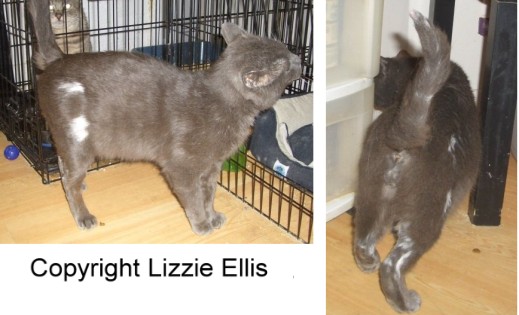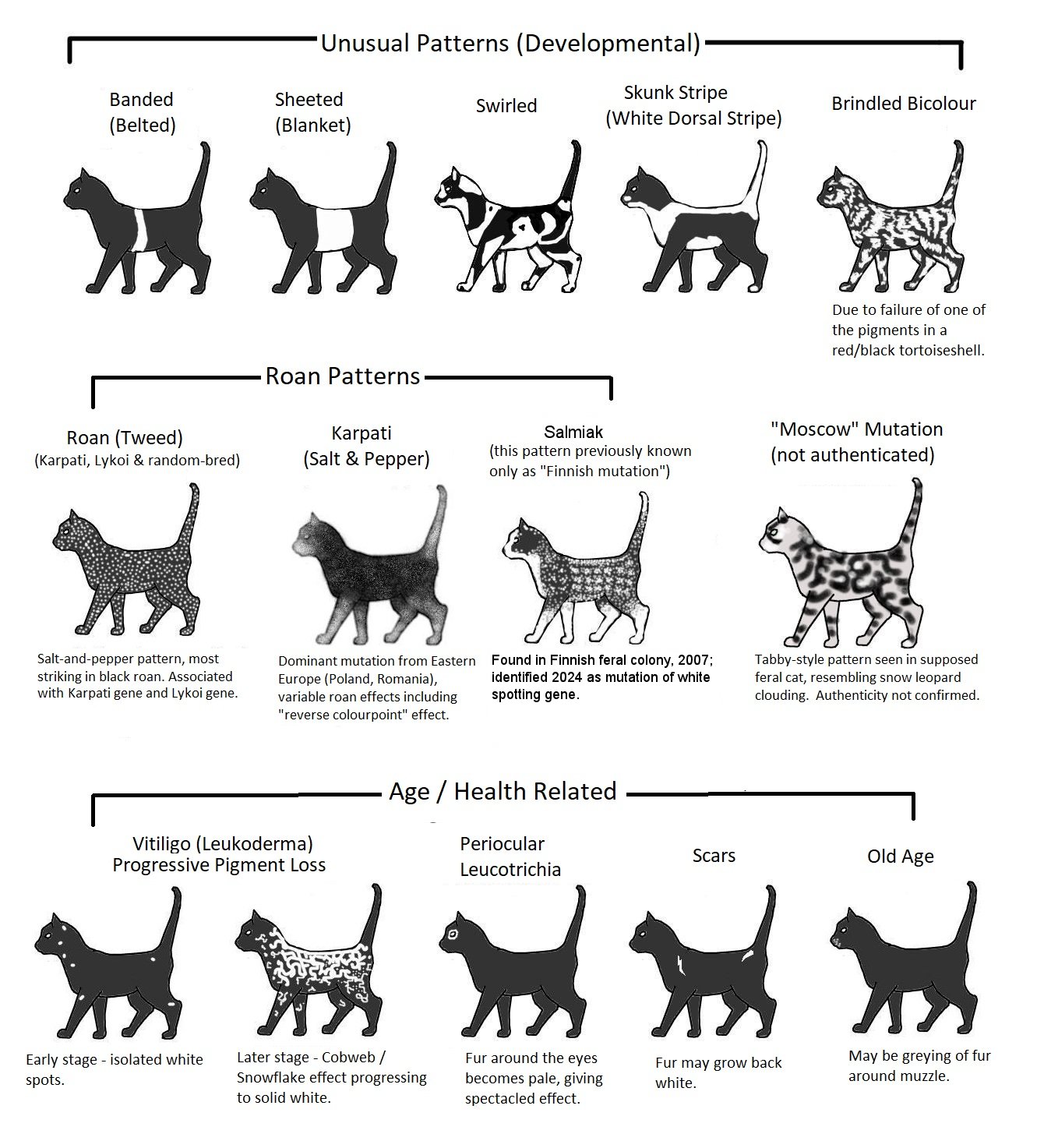
FELINE DEPIGMENTATION CONDITIONS – VITILIGO, LEUKODERMA, LEUKOTRICHIA
Leukoderma ("white skin"), leukotrichia ("white hair") or vitiligo, is a cosmetic condition that produces a "cobweb" or "snowflake" effect and is most easily seen on black cats. White spots appear on the coat; these become more extensive with age until the cat has a white lace pattern on the black fur. Ultimately the cat may go completely white or be left with diminishing isolated patches of colour. This condition has been seen in black leopards ("cobweb panthers"), humans, dogs and other animals. This must not be confused with the normal sprinkling of isolated white hairs which appear in a cat's fur during its lifetime. "Leukotrichia" is a generic term. Acommon term is "piebaldism" because it causes white patches in the skin and fur. It is an "aquired depigmentation" that occurs during the cat's lifetime, is usually progressive and may be triggered by illness or environmental factors. Ultimately, a cat with leukoderma may become almost entirely white. Antibodies are formed against the pigment-producing melanocytes. The melanocytes are destroyed leading to the white areas. It is a cosmetic condition that doesn’t affect health except for the increased possibility of sunburn to depigmented areas. A type of leukoderma has been identified in some Persian cats and these are used as laboratory subjects in the study of depigmentation conditions. Periocular leukotrichia, causes the fur around the cat's eyes to become pale - as though the cat is wearing spectacles.
Vitiligo is one form of leukoderma. Originally this was thought to be rare in cats, but thanks to social networking and the internet, more and more cases are coming to light. it usually causes loss of pigment on the face and feet. Antibodies are formed against the pigment-producing melanocytes. The melanocytes are destroyed leading to white areas of fur or pink areas of skin. This form of vitiligo has been found in cats derived from South-East Asian stock i.e. Siamese, Burmese and related breeds. This may be due to the founder effect where early imports, or an influential stud, passed on the gene(s) for vitiligo. Those genes might not be expressed unless triggered by some external event e.g. stress or illness (both of which release stress hormones).
In human medicine, vitiligo is classed as an immune system condition and subdivided into segmental and non-segmental. Segmental vitiligo tends to occur around the teenage years and forms a stable, usually unilateral (asymmetrical) pattern. It affects areas of skin associated with dorsal roots from the spinal cord. It is predictable in how in progresses. Segmental vitiligo is rapid-spreading on the skin and (in humans) can be treated with ointments. Non-segmental vitiligo exhibits a degree of symmetry in the location of the white patches (e.g. occurs on both hands, not on one hand) and can be generalized over large portions of the body or localized to a particular area. It can occur at any age and is categorized as follows:
Generalized Vitiligo - the most common pattern; wide and randomly distributed white patches
Universal Vitiligo - depigmentation over most of the body; leaving a few residual white spots/hairs - the progressive "cobweb" or "snowflake" form
Focal Vitiligo - a few scattered white spots form in a single area of the body (most common in the very young)
Acrofacial Vitiligo - fingers (in cats: paw-pads) and around body orifices (e.g. mouth, nose, anus and genitalia) - seen in some colourpoint cats
Mucosal Vitiligo - depigmentation of the mucous membranes only including nasal, lips, eye-rims.
Human studies indicate that changes in the immune system are responsible for the condition and that both underlying genetics and environmental triggers are involved. In other words, an individual may inherit (and pass on) the genetic potential for depigmentation, but it takes some other factor to start the depigmentation process. That other factor could be age or hormone related or it could be illness or stress. However, most vitiligo seems to be "unknown origin" with no obvious triggers and we don't know what has started the process.
There are several types of leukotrichia found in mammals. Luckily cats don’t seem to get the painful versions that cause lesions and crusty skin in horses.
TYPES OF VITILIGO SEEN IN CATS
Although no genetic analysis has been done, visual inspection suggests there are several forms of feline vitiligo that develop in different patterns. Until there’s more genetic/veterinary information I’ve simple classified these by visual effect.

VITILIGO OR KARPATI PATTERN?
In 2014 some curious black and white cats were reported from the Carpathian region: Hungary, Poland, Ukraine, Slovakia, Romania. These had silvery-white tails, toes/feet, ears and muzzle, but were otherwise black or salt-and-pepper pattern. The cats were born with pale colouration that darkened over time except for the points. In 2017, a cat from Romford, England, called Panda Kitty turned up with this pattern. Although he is claimed to have vitiligo, his pattern is actually more indicative of the karpati mutation (a dominant gene). Below is a karpati pattern cat from Poland. Karpati can occur with any colour fur, but is more pronounced on black cats that inherit the gene.
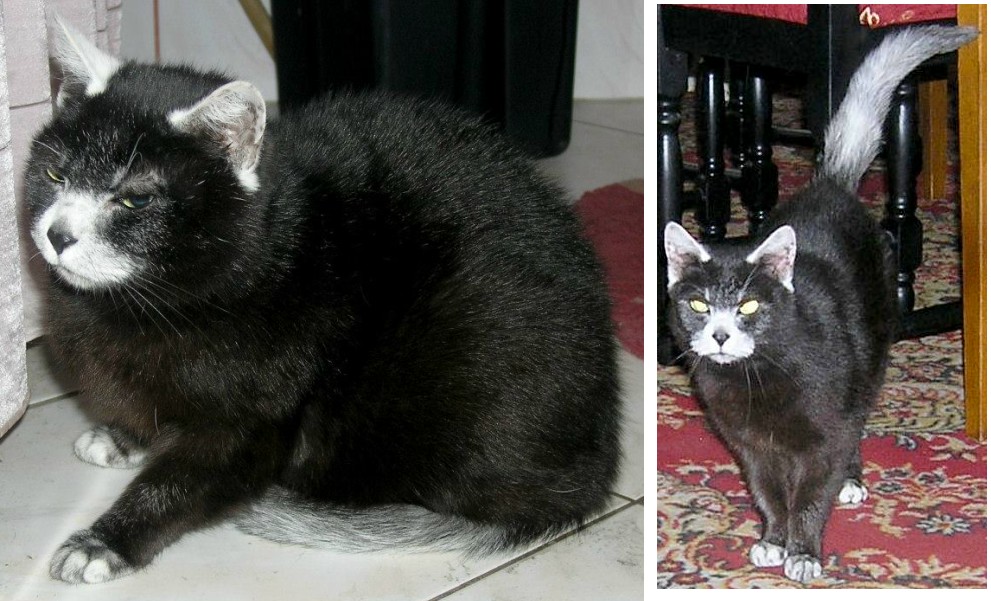
COBWEB
White speckles appear throughout the coat; these become more extensive with age until the cat has a white lace pattern on the black fur. Ultimately the cat may go completely white or be left with diminishing isolated patches of colour. This condition has been seen in black leopards ("cobweb panthers") and similar conditions are found in humans, dogs and other animals. This must not be confused with the roan pattern, the “Salt and Pepper” mutation or the normal sprinkling of isolated white hairs which appear in a cat's fur during its lifetime. This should not be confused with the “Salt and Pepper mutation” in Eastern European cats which develops early on, but stabilises to give a “reverse colourpoint” effect.
|
|
|
"Charva" (Jason Reeves) has vitiligo; she was a black cat with patches of slightly longer/softer black hair. In 2009 she turned 4 and developed a patch of white hair. Since then the patches of white have turned into stripes, spots, and patches. Her skin is turning pink as well due to the loss of pigmentation.
SNOWFLAKE
In this form of pigment loss, white spots and small patches appear on the fur, exactly like snowflakes. Just like snowflakes, the white patches increase in number until the cat has little or no original colour left.
Pam Pramuka's cat "Aka" was adpted at about 2 years, all black but with a scattering of individual white body hairs that were longer than her base coat. By 2 years 6 months she had developed widespread white ticking and some splotches, which continued to grow until age 3. By 3 years and 6 months, the patches stopped forming, or formed only slowly so that the pattern seemed to have stabilised. Aka was a a shelter kitty, taken in as a stray.
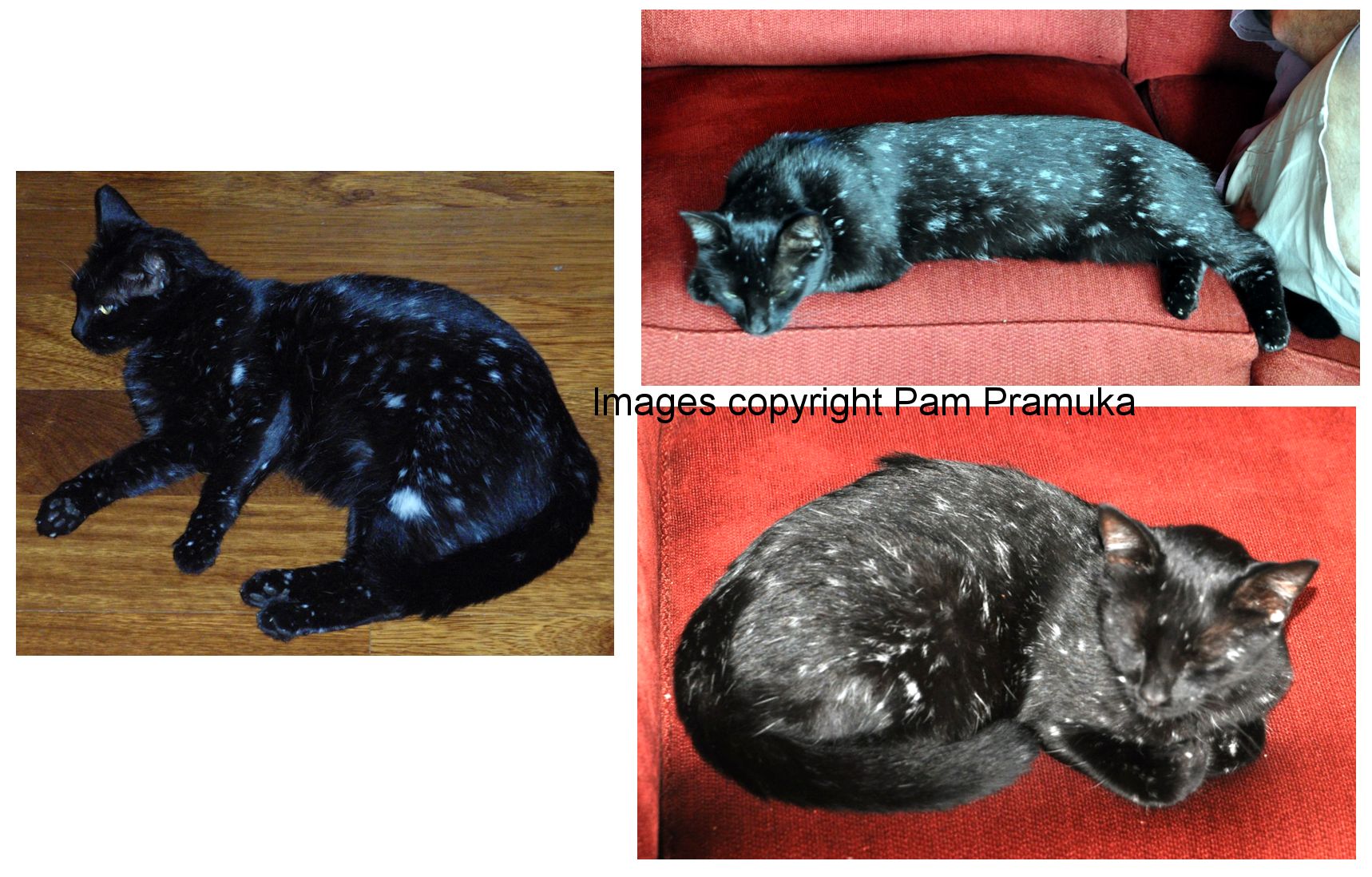
Carena Hall photographed "Mosaic" photographed at a shelter in 2012.
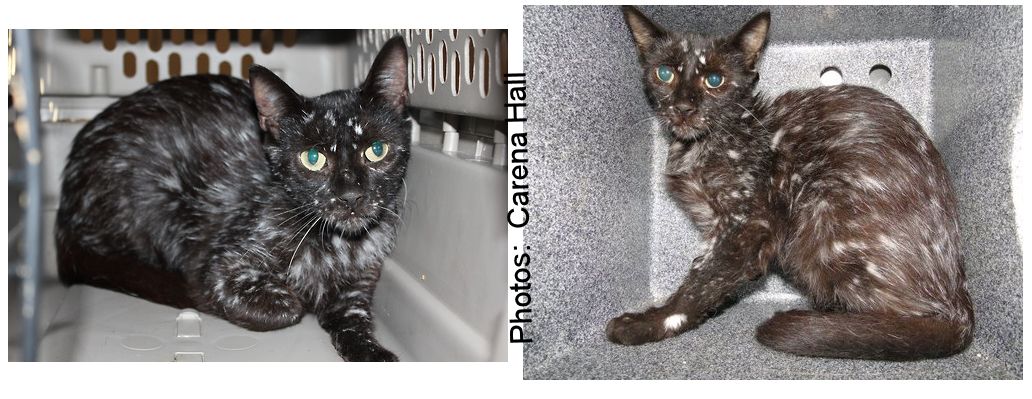
Below is a series of photos sent to me showing the progress of vitiligo.
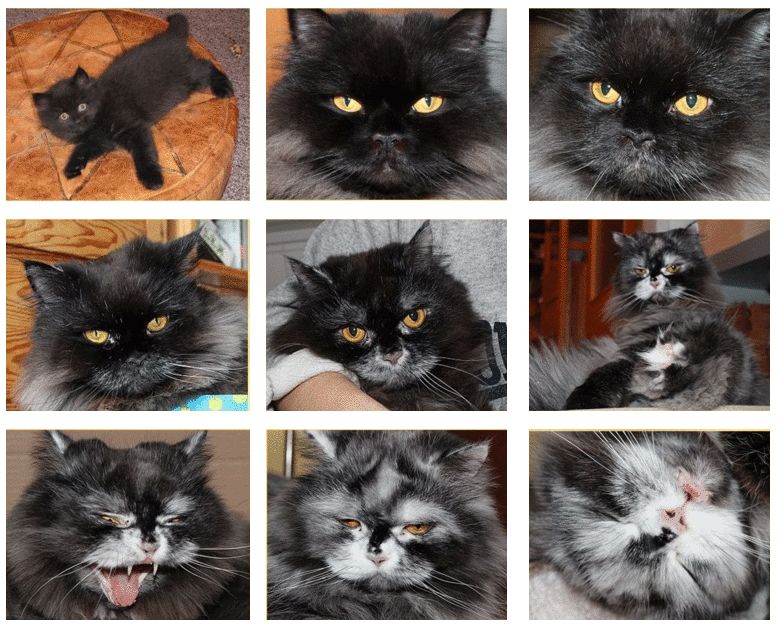
One of the most stunning examples is this photo which has been popping up all over the internet with people questioning its authenticity. It's a black cat with advanced vitiligo; the white colour now dominates the coat.
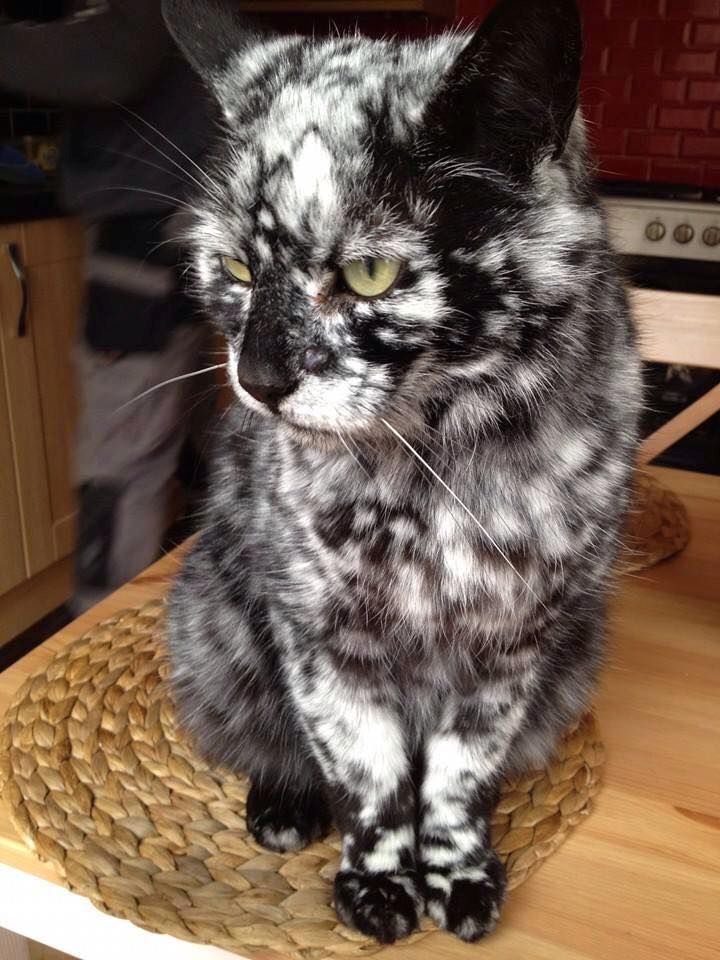

Vitiligo is not confined to black cats, but may not be as obvious on other colours. In 2011, Kimberly Sexton of New York City sent these photos of her cat Frankie. Kimberly's 14 year old cat Miko (white with grey markings on his head and tail) had recently died and in his last 3 years had formed a close bond with her younger cat, Frankie, a mackerel tabby. The two cats often slept intertwined. Two years before Miko passed away, Frankie developed a white spot of fur under his neck, while his chin and nose became paler. As time passed, Frankie's white areas spread and new ones developed around his neck and behind his shoulder blades. Kimberly joked to friends that Miko's white colour was rubbing off on Frankie as they slept! Frankie's white areas are likely to continue spreading, but the effect appears entirely cosmetic.
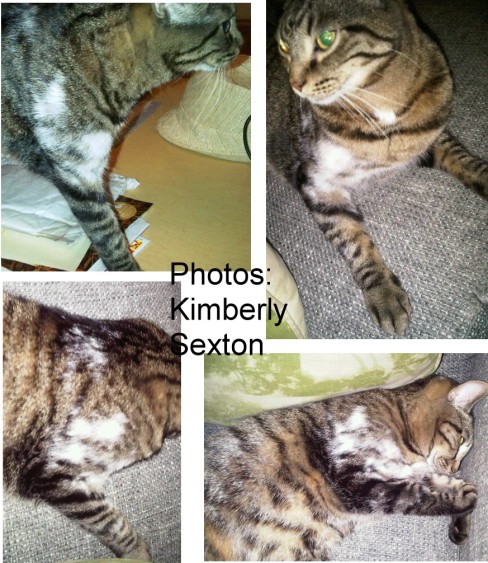
At 18 months old this self black Shorthair he was jet black all over. After his 2nd birthday he started to get white patches in his neck and these became progressively larger. His nose and face remain black, but his whiskers are now white. His siblings have not developed any white patches and there is no history of the condition in his immediate ancestry (he has a recorded pedigree), so it appears to be a random mutation. With each moult more white hairs are likely to appear and he will probably end up predominantly white/pale-grey.
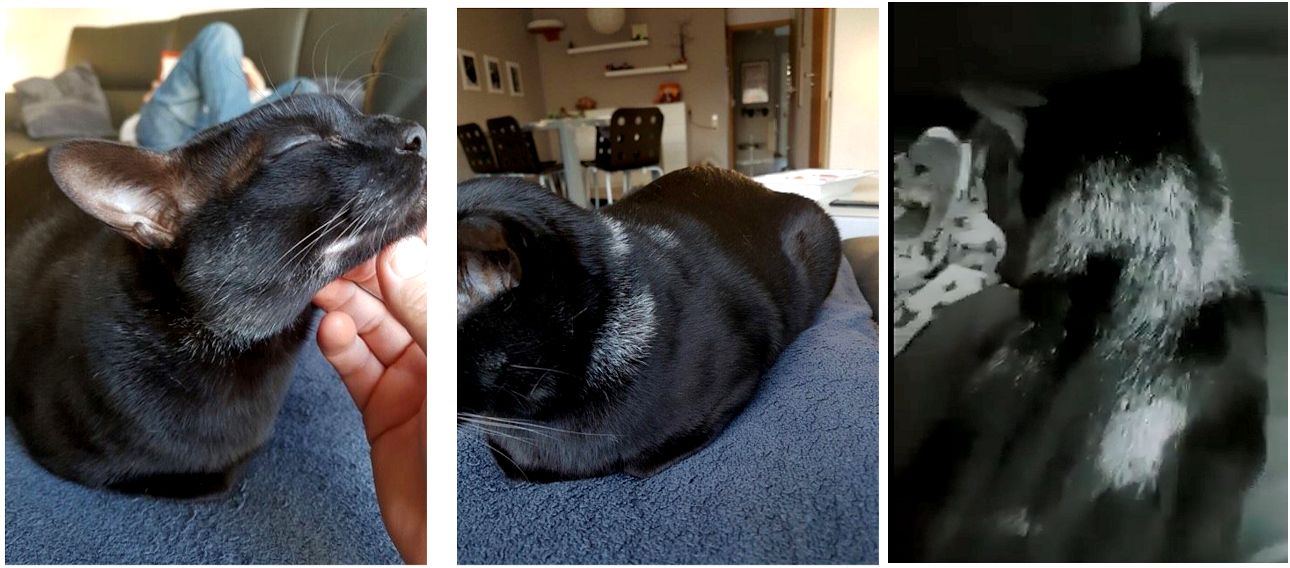
In November 2019, Iryna Merzlenko sent me this photo of her 6 month old black cat, Jinx, who was born with white spots. As he grew older the number of white spots have increased and grown larger. The photos show the white spots at the ages of 3 weeks, 2 months and 6 months. The greatest change was around 6 month, probbly due to moulting the kitten coat and the some of the new fur growing back white instead of black. The mucous membranes of the eyes, lips, paw pads, and nose leather are not affected. Iryna is an experienced breeder (Topaz breed) will mate Jinx to one of her black females to see if this is inherited.
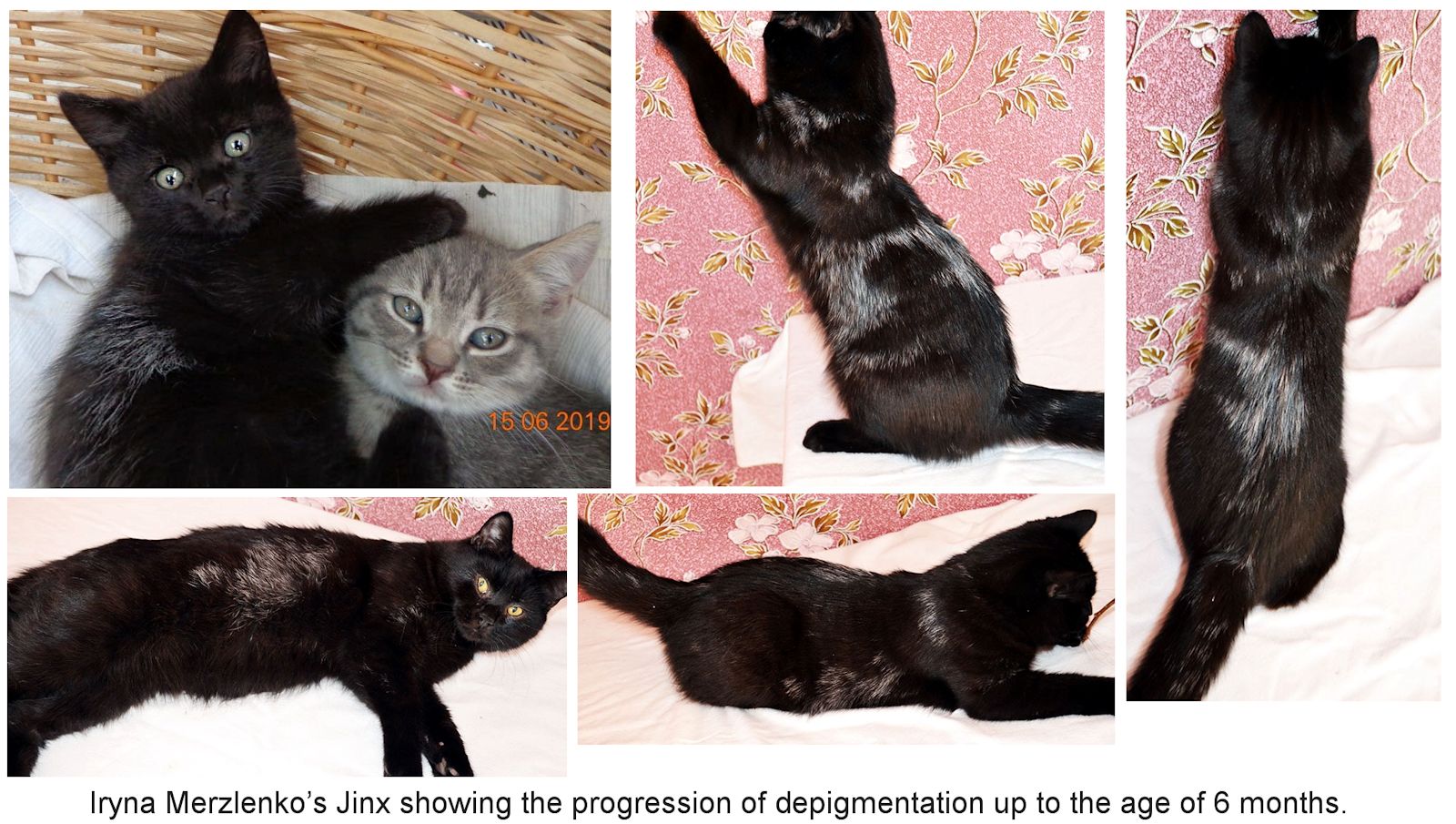
In November 2019, I received these pictures from Kristen of her cat Kirby, who had been rescued from the Hawaii jungle at the age of 6 or 7 weeks. He was extremely underweight, with a bad infestation of fleas and hookworms and was completely black, except for a tiny white patch on his chest. As Kirby recovered and grew, he began to slowly grow white hairs on his legs and body. At the age of 3.5months he is noticeably speckled with streaks of white and grey against his pitch black fur. Although fever coat was suggested this is generally present from birth (although it can occur following serious illness), but Kirby did not start getting any white hairs until he was about 2.5 months. Kirby has been pronounced healthy by the vet and is very happy and active. He now has a distinct ring of grey fur around his tail, almost like a raccoon. The fur on his tail has grown in with a slightly wiry texture. What is noticeable is that his guard hairs have grown in as white hairs giving him a slightly porcupine appearance. At the current rate of development, Kirby will be completely white by 1 year old! Kristen is watching Kirby’s fur with interest to see if the depigmentation continues, halts or even reverses.


Beretta is a random-bred domestic shorthair from the USA. He was 11 years old in 2025. His owner, Abigail, considered him a solid black cat with a locket spot of about 5 white hairs which he had since kittenhood. At around 5 years old, his left front leg started to grow random white hairs. At around 8 years old, the white fur on the leg was noticeably denser, and Beretta took to growing 2 white whiskers among the black ones on his right face. At 11 years old, the white leg hairs have continued to slowly multiply and have connected to the little group of white hairs on his chest and wrapped up into his left armpit. He has maybe a dozen more white hairs all over his body. There is no white around his muzzle and his right leg remains completely black. This is a very slow case of depigmentation.
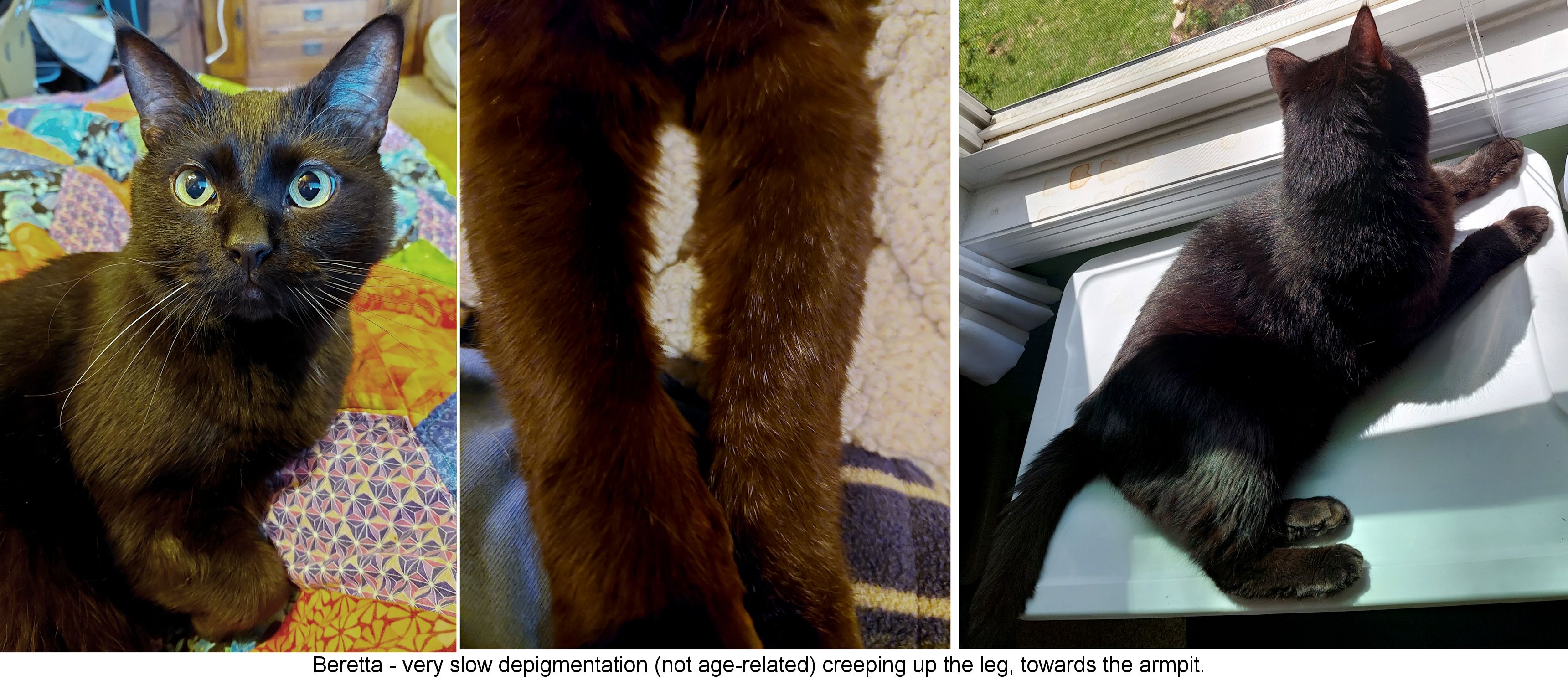
VITILIGO OR CHIMERA?
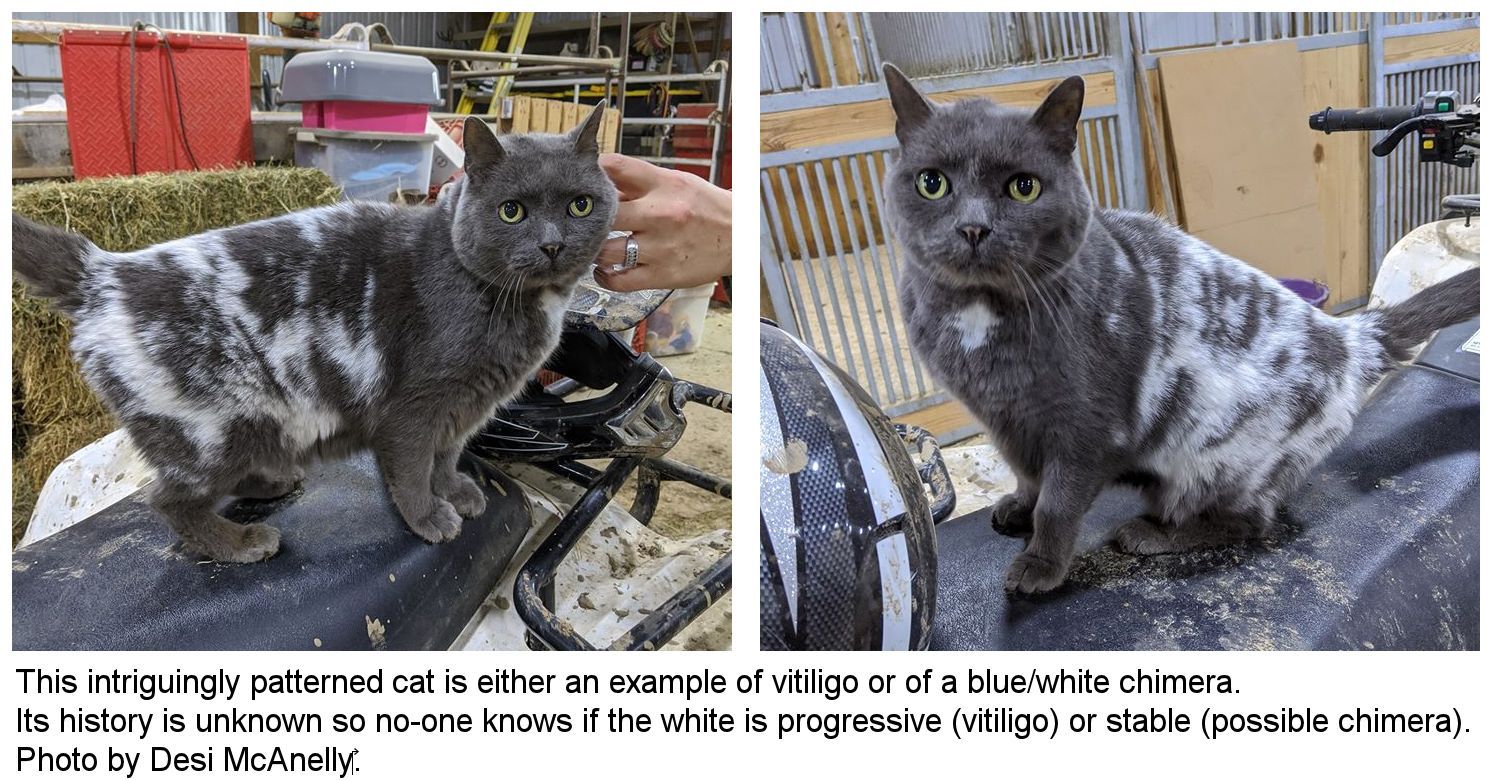
FACIAL DEPIGMENTATION IN COLOURPOINT CATS
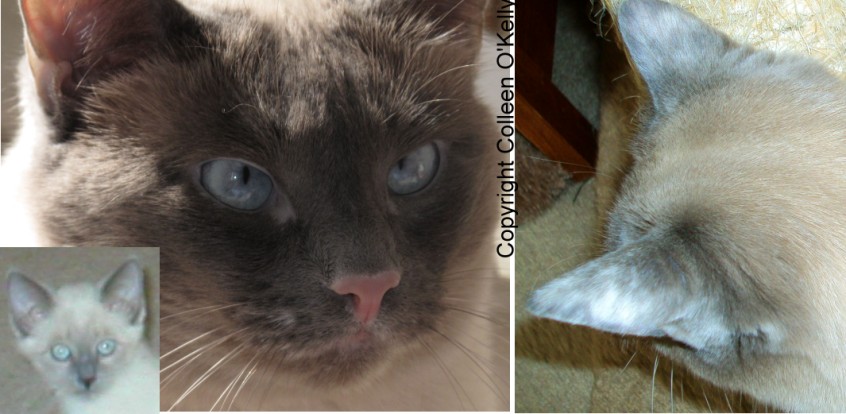
Vitiligo is not confined to black cats, but is harder to spot in lighter colour cats. Colleen O'Kelly, a physician in the USA, has a lilac-point Siames called Gracie tht has vitiligo. Her point colour was normal as a kitten, but over time her ears have become cobwebbed with white and her muzzle is now showing a similar lightening. Most strikingly, her nose has lost its dark pigmentation and her whiskers on one side have turned white.

This pattern of pigment loss is found in cats with South-East Asian ancestry i.e. cats with Siamese colour restriction, Burmese colour restriction and the intermediate mink pattern. This suggests the tendency to develop white patches was inherited from an early import or from an influential stud. Some breeding lines are more affected than others and some appear unaffected. Pigment loss is primarily on the lips and nose leather, where it is noticeable, and also on the paw pads. In “Gracie” the ears were also affected.
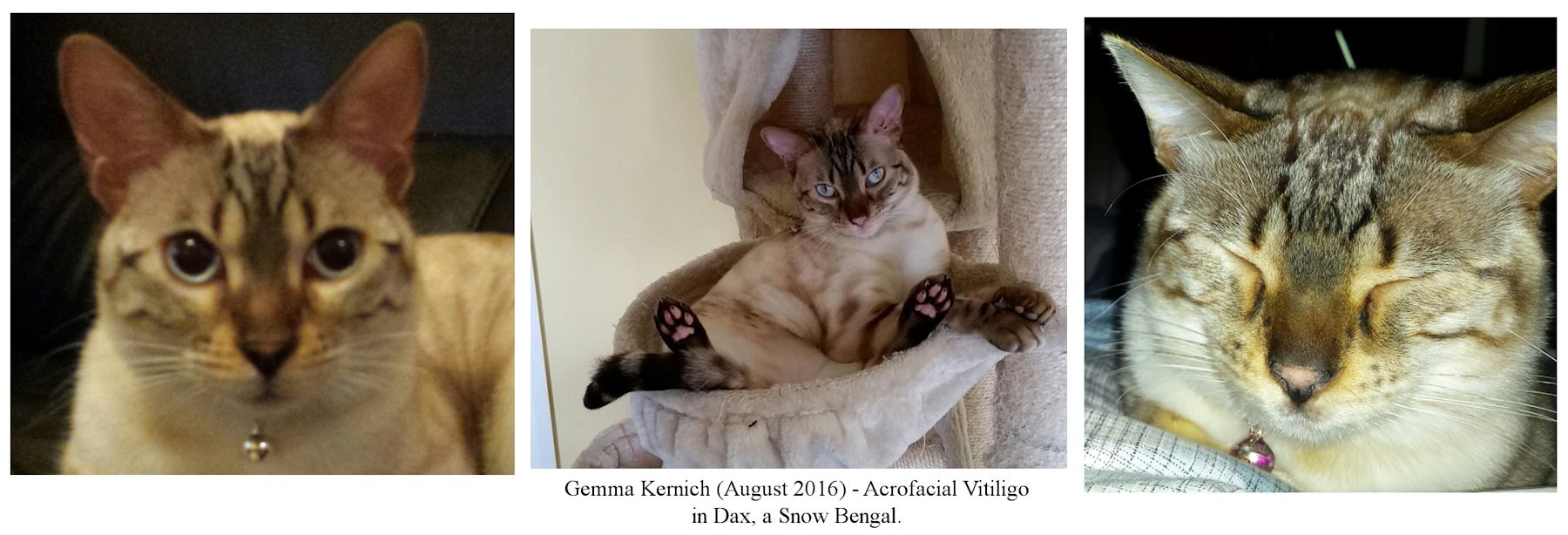
Dax is a Snow Bengal owned by Gemma Kernich. He has Acrofacial Vitiligo. This causes pigment loss in fingers (in cats: paw-pads) and around body orifices (e.g. mouth, nose, anus and genitalia) and is found in some colourpoint cats. Dax had black paws, nose and lips at the beginning of 2016, but by August 2016 - when Dax was almost 24 months old. Gemma had researched Dax's pigment loss and discovered that trauma can trigger the gene. Dax broke his hip aged 10 months and required surgery, but Gemmabelieves the depigmentation on his nose had started before this trauma.
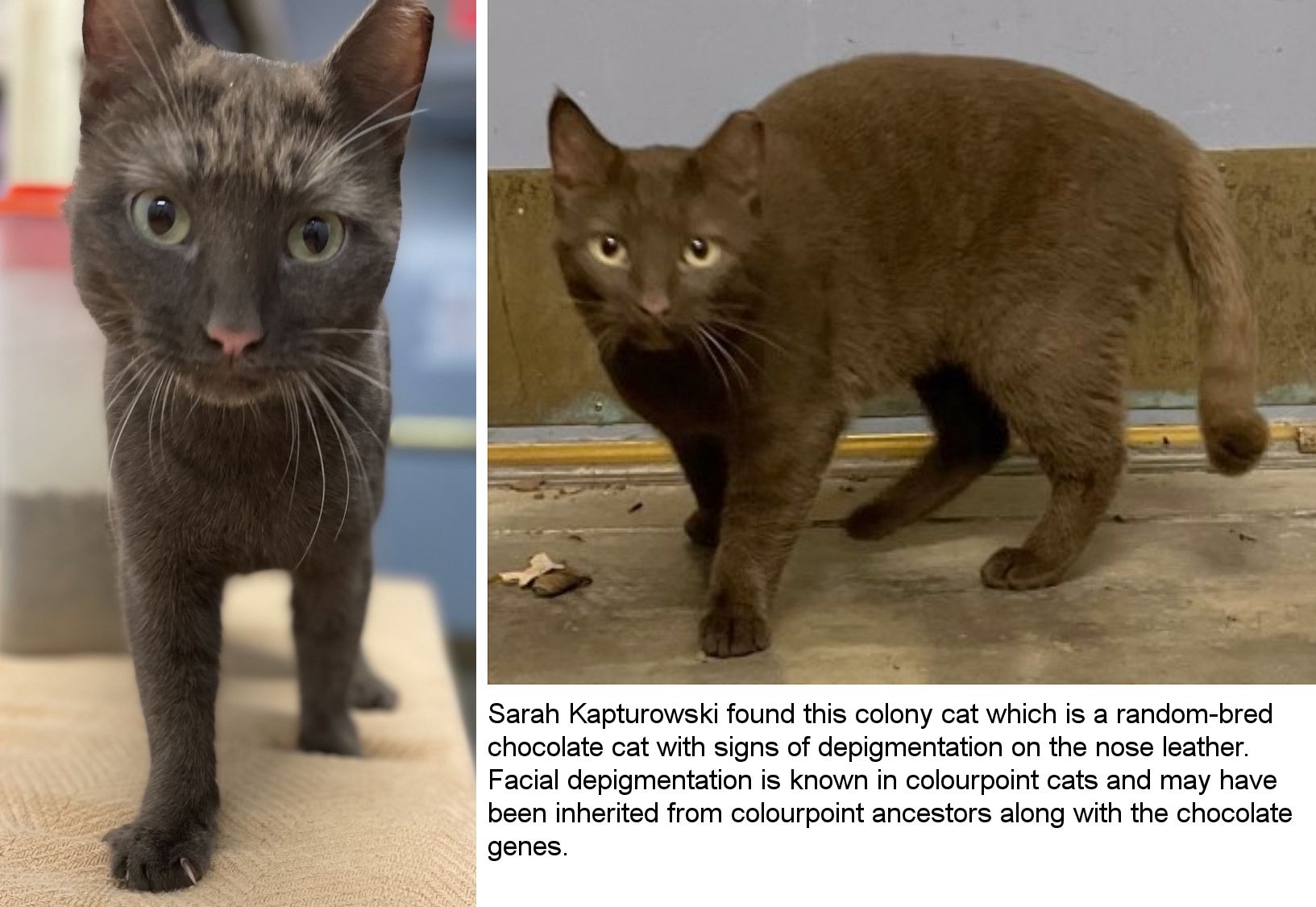
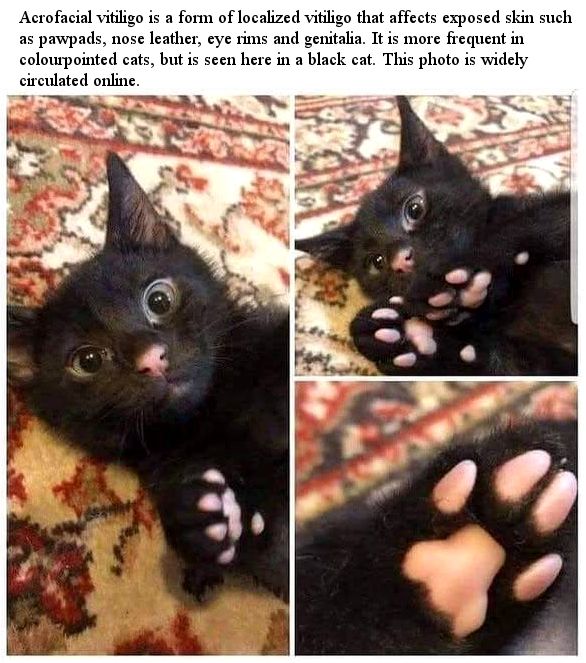
PAWPAD VITILIGO
In 2021, Vivian Tzari Andresen’s 9 month old solid (or possibly low grade smoke) cinnamon Selkirk Rex, Hayu, developed white patches on his paw pads on all 4 feet. There are no white patches on the lips, inside the mouth or on the bare skin around the eyes, so it was not acrofacial vitiligo. Some types of vitiligo only affect exposed skin. After ruling out possible illnesses, Vivian adopted a watch-and-see approach, monitoring the patches for any changes in size. There is no history of vitiligo in the ancestors.
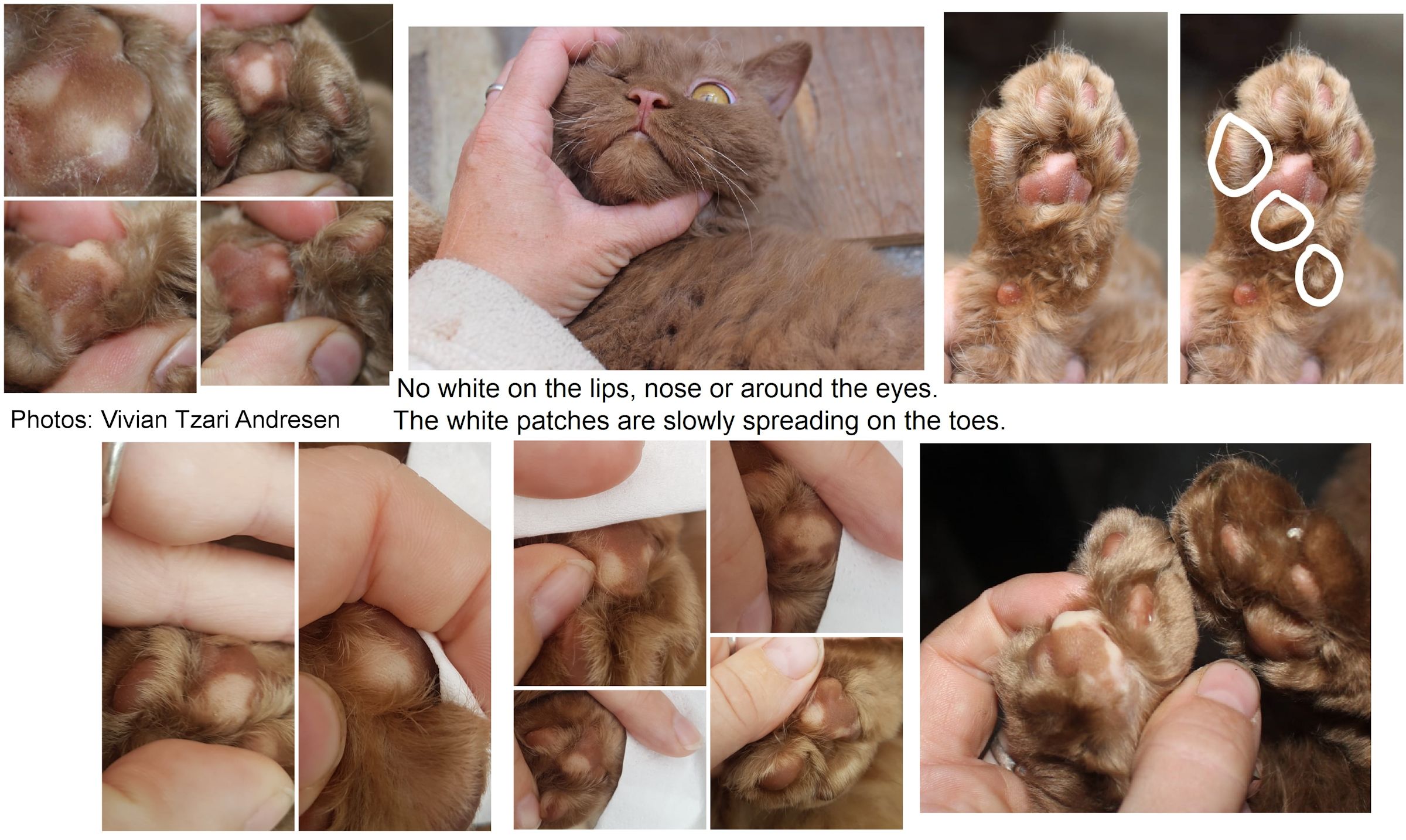
The only other oddity in this family line is a white belly spot that very occasionally appears. Grandparents Lykken Peer Gynt and Lykken Curly Tsarina of Tzari, and their 2 daughters (Tzari Amphetamine and Tzari Partytrooper) have no white. Amfie and Party were mated to 2 different males. Amfie had a litter of 5, 1 with a white belly spot. Party had a litter of 4 (one with belly spot) and a litter of 7 (one with belly spot). This is either a very low level of white spotting or a white scar around the navel.
ILLNESS-RELATED / STRESS-RELATED RELATED DEPIGMENTATION / FEVER COAT
In October 2018, Alison Nishiyama sent me these photos of her cat, Reuben Carnitos. He is a chocolate coloured cat with diagnosed with idiopathic epilepsy and chronic constipation (both well managed), and very healthy otherwise. Reuben used to have a fully pink nose, as well as all pink paw pads when he was younger. Over the course of a year slowly his nose leather changed to a chocolate colour, but his paw pads remained a very bright pink and did not turn chocolate or a dark rose-pink as one would expect. Reuben was from a hoarding case and initially suffered from intermittent illness. His body hairs used to have less white patches/white hairs, but after the gran mals (epileptic episodes) showed up before he was adopted, his scattered white hairs increased. This suggests a stress-related link. After he was adopted by Alison, he has been almost seizure-free and the return of pigment to his nose and lips, and reduction of white patches appears related to not having seizures.
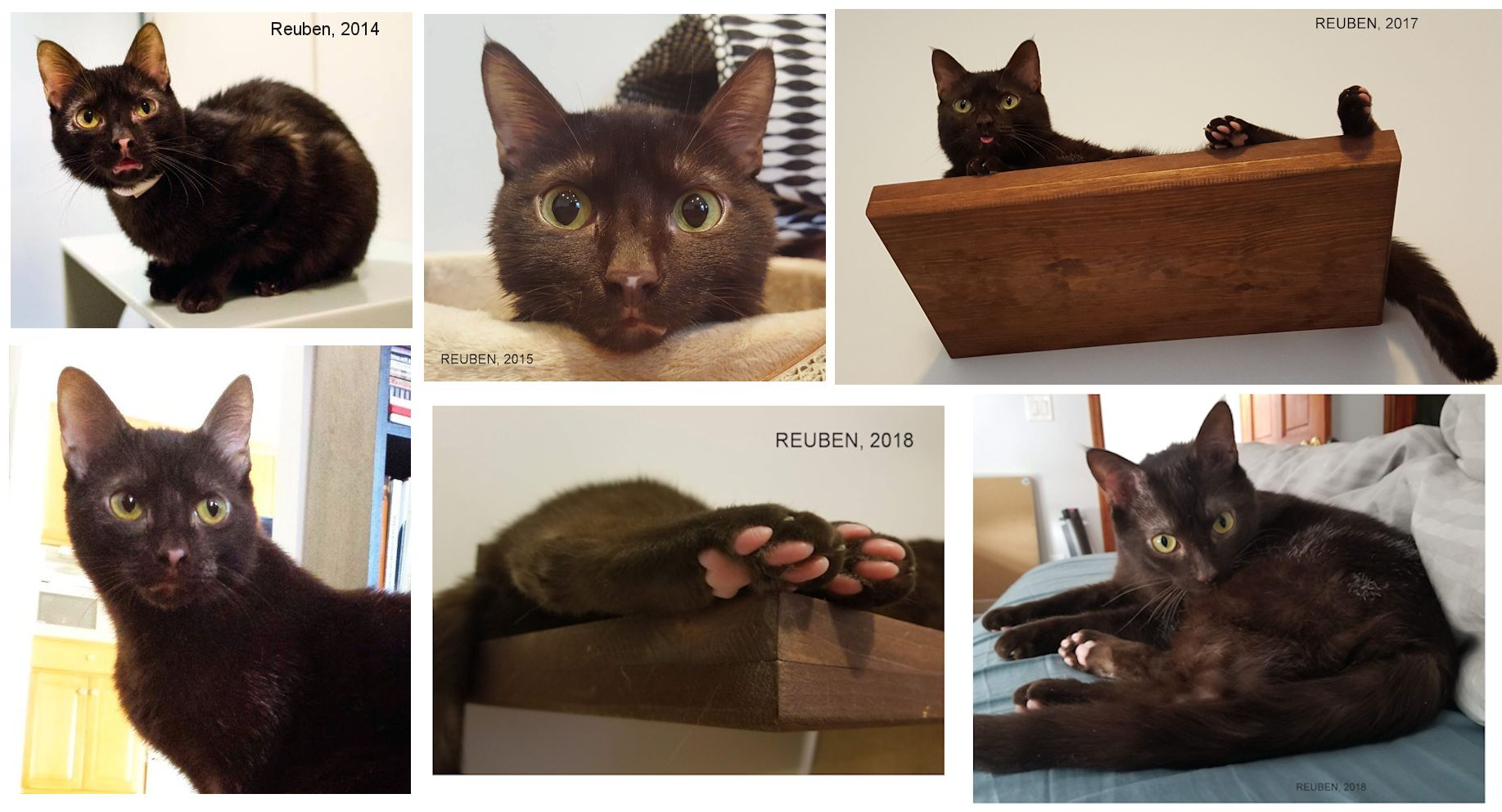
Ulli wrote to me about black Persian cat Meriadoc. Meriadoc was pitch black until 3.5y old. In the summer 2012 he started with getting white eye lids. However, since being shaved, his fur has reverted to black which suggests (to me) the pigment loss was temporary due to illness or even stress.
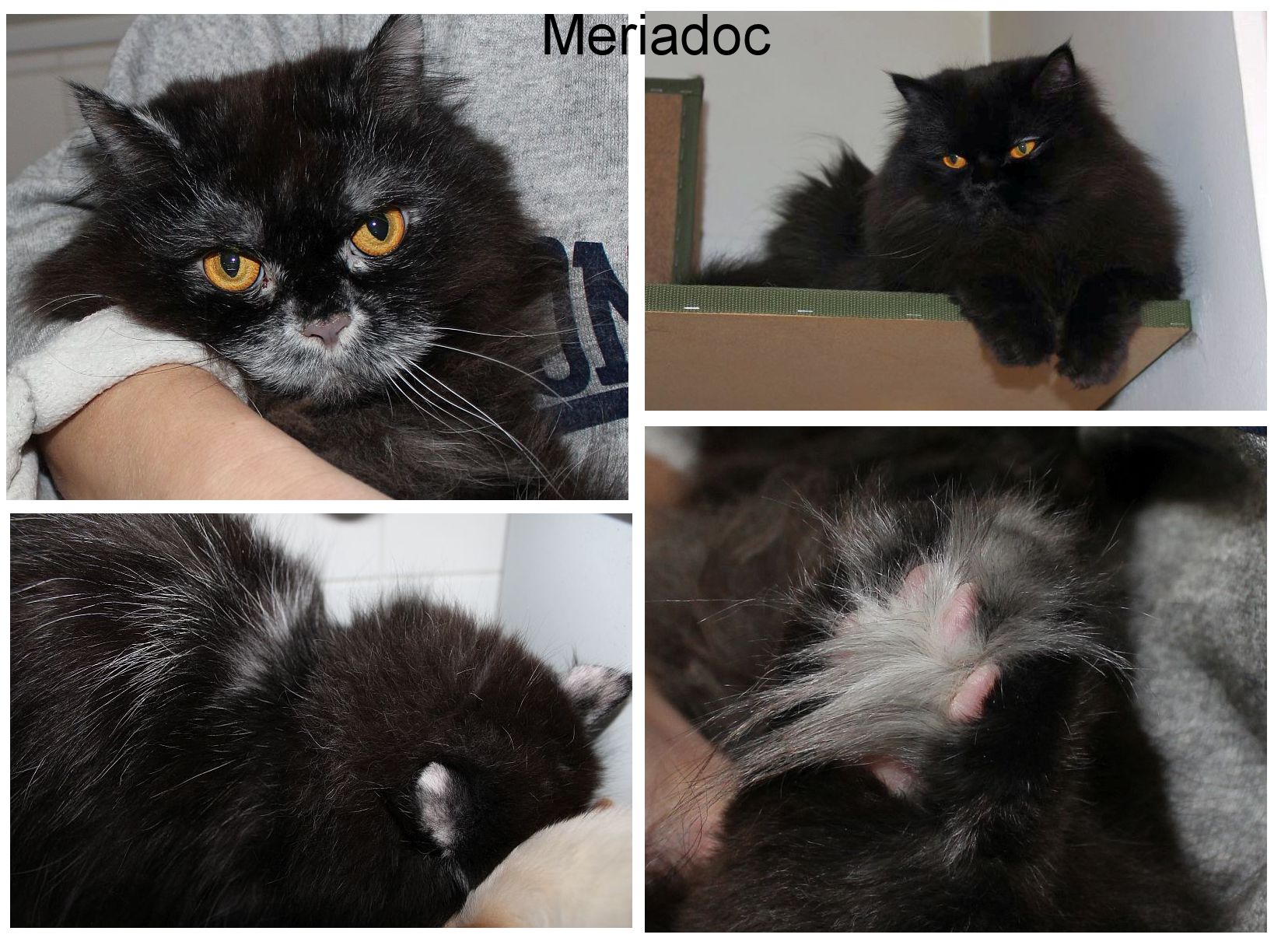
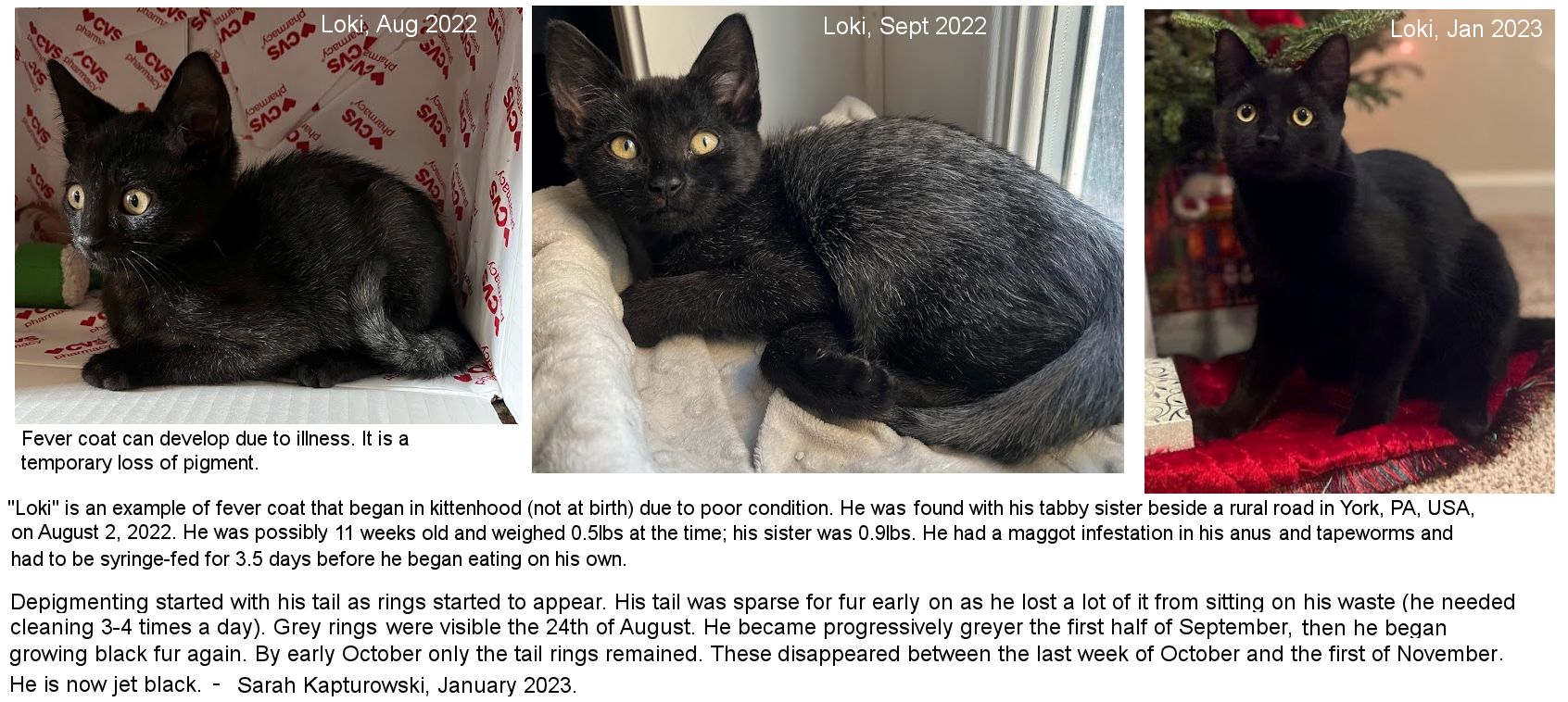
GENERALISED PROGRESSIVE PIGMENT LOSS
Neptune is owned by Karen Tanner and has turned from black specked with white to white speckled with grey! At the same time, he has some unique white markings on his face, and his nose has turned black at the same time as his fur lightened. Karen acquired Neptune from a Humane Society in San Jose, California in 2001, when he was at least 1 year old and already neutered (so no possibility of seeing if his trait is hereditary). In earlier photos he is black with white speckles and a pink nose, plus an unusual white splotch on his tail (which is now more or less gone as his colour changed). His fur started getting gradually lighter and his nose darker. By 2004 he still had a pink nose and the white splotch on his tail, but by 2012 he looks a pale grey and his white splotches are harder to discern.
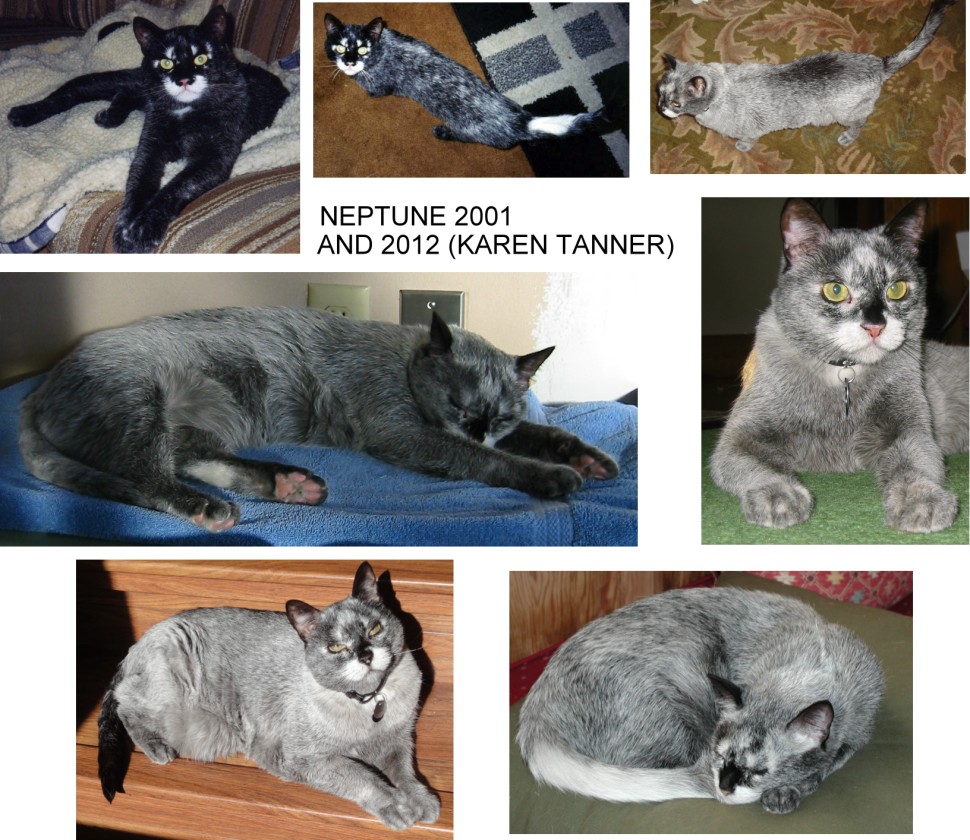
Generalised pigmentation loss, starting with isolated white spots, can occur on any colour coat. Saara Tuovinen from Finland wrote to me in February 2016 about her registered classic red tabby British Shorthair called Oliver. He is a little over 2-years-old and since the age of 1.5 years he developed an increasing number of a white spots on his fur. Oliver has been used as a stud once (with a bicolour female) after conferring with judges at the international cat show. Saara wanted to rule out the silver gene because Oliver has ancestors with silver. Olivers' father (chocolate tabby) has some de-pigmentation on the paws, only noticeable at the age of 2 years which was after he had sired 7 kittens. Oliver has 5 full siblings and one half-sister (chocolate spotted) from same father. His half-sister developed some depigmentation at the paws at the age of 5-6 months, but none of his full siblings have developed white spots. By August 2016, none of Oliver’s offspring (7 months old) had any signs of vitiligo, but Oliver himself had become more white than red. Like Neptune (above) the depigmnentation is most porminent on the muzzle and the tail (from base to half-way along).
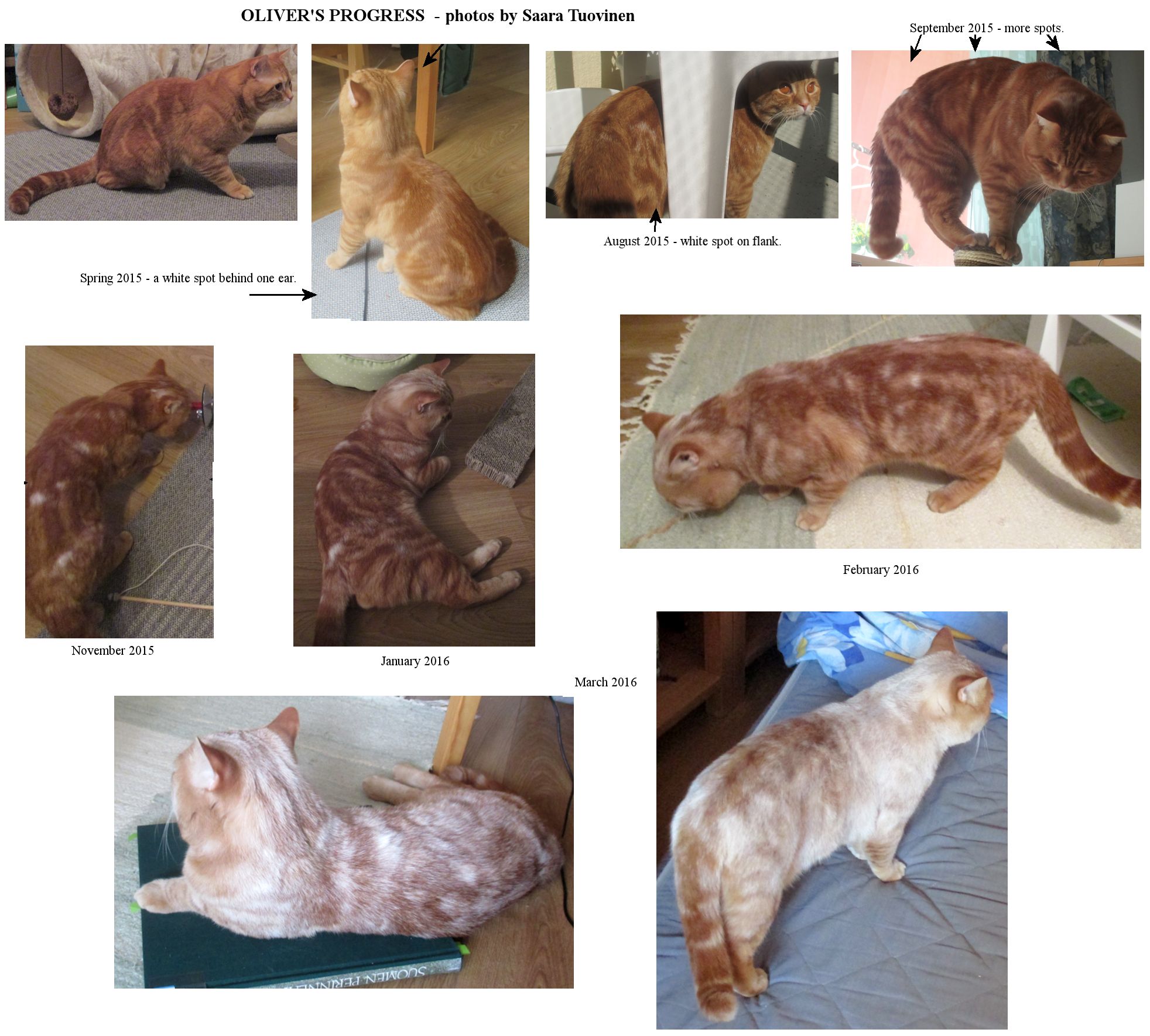
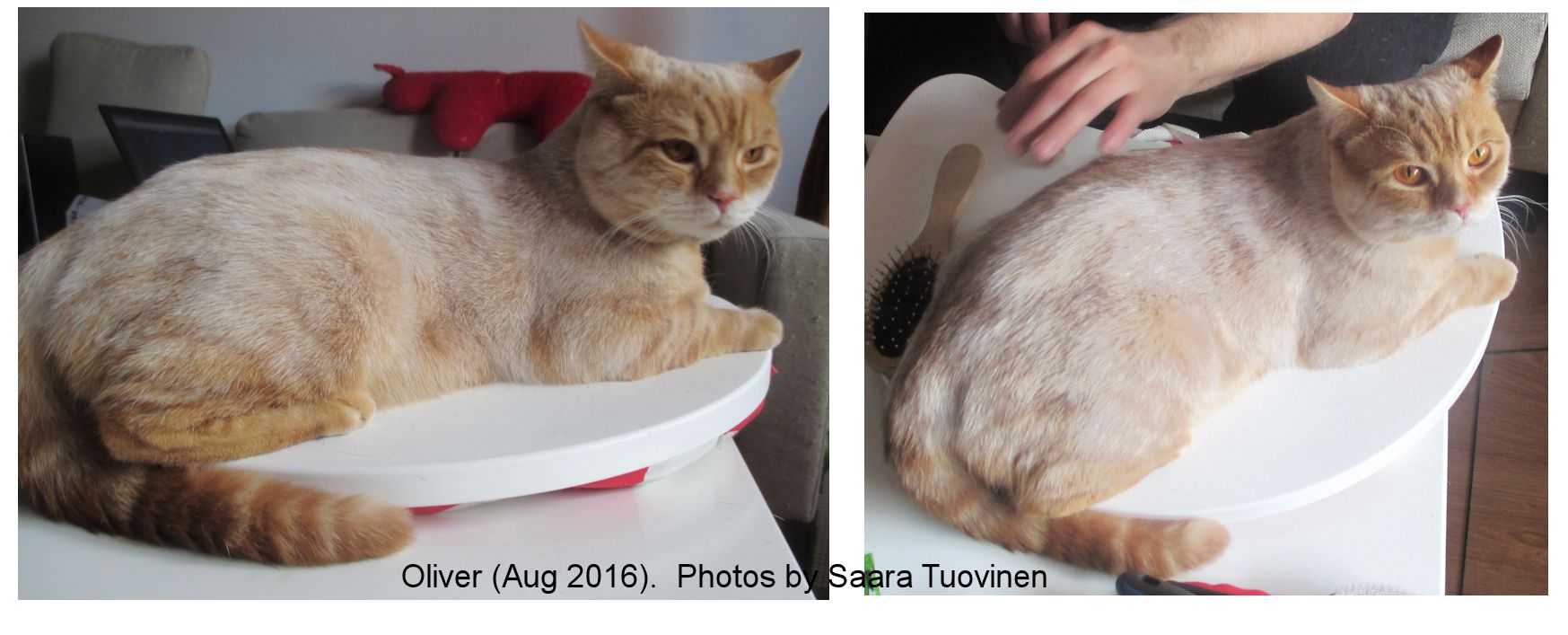
The photos below (by Michael Eastwood) erroneously claimed to show an extreme case of slow melanocyte migration to the skin and fur, making the cat almost completely white over the period of 6 years. This is incorrect. Melanocyte progression, as discussed in the article it accompanies, occurs only in the developing embryo and affects the distriubtion of coloured patches appear on the body surface. In fact the series of images shows progressive pigment loss due to apoptosis (cell death).
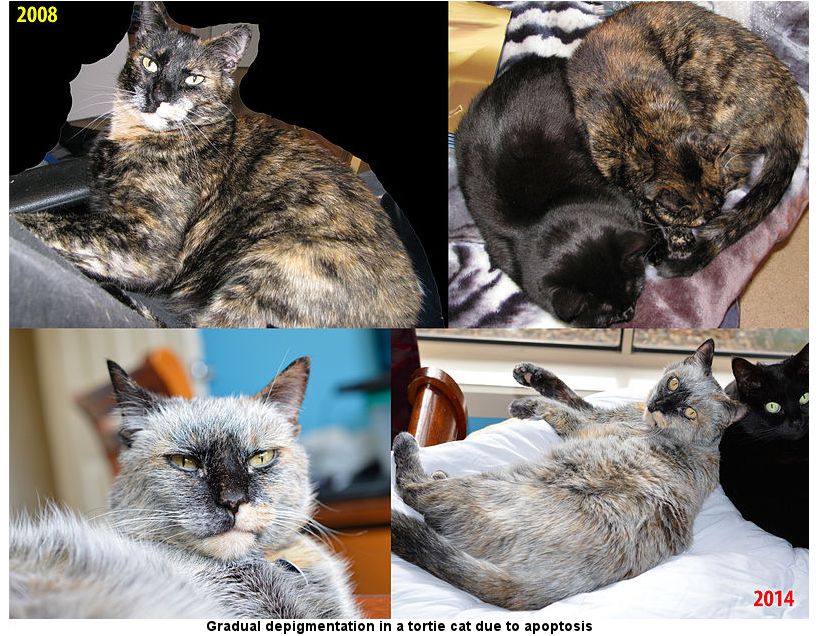
Chocolate Oriental Shorthair, Okonor Saman, also shows depigmentation spreading on the body - it has not yet spread to the legs, belly, tail and face.
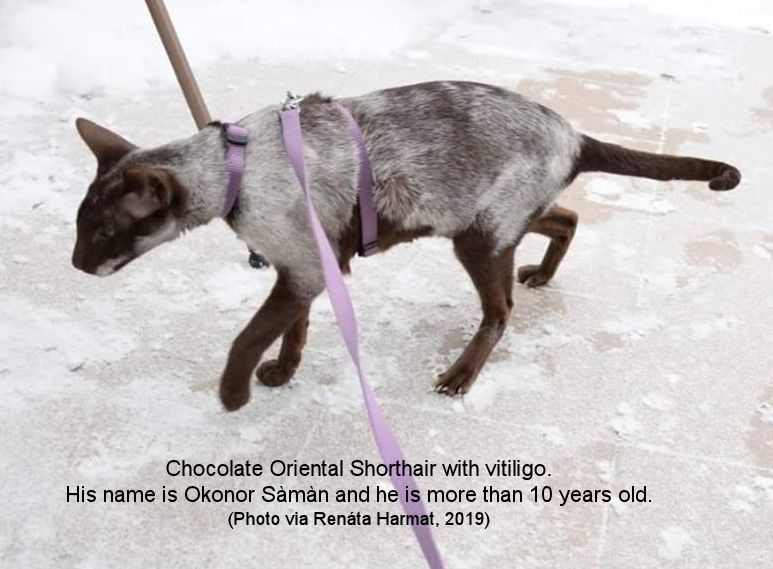
Another case of progressive depigmentation was reported to me in May 2019. This was an adult rescue cat with pronounced roaning in the typical pattern as seen abobe.
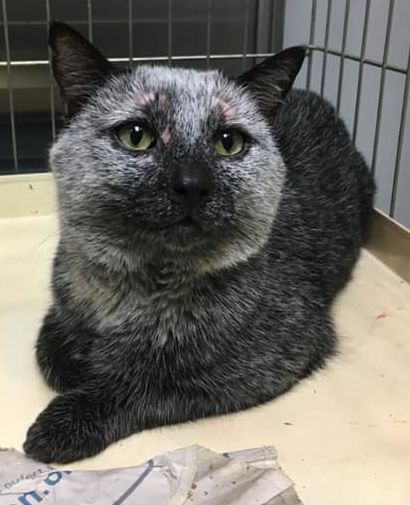
OTHER ACQUIRED DEPIGMENTATION
On coloured cats, hair regrowth around scars is often white. Some dark coloured cats show white hairs in their coat as they grow older - some follicles stop producing pigment, just as humans get "grey" hairs. Unlike the cobweb effect (where pigment loss occurs in patches, like snowflakes or strands of gossamer), age-related white hairs are evenly sprinkled across the body giving a salt-and-pepper effect; there may also be greying around the muzzle. It is a normal part of ageing although cats seem far less prone to getting grey hairs than do dogs. It should not be confused with the white patches found in vitiligo. In "Salt and Pepper" muttion in Eastern European cats, the pigment is lost at the points, but this stabilises into a distinctive pattern.
